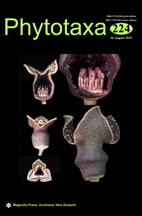Abstract
The aim of this study was to describe the new rhodolith-forming coralline alga species, Sporolithon yoneshigueae sp. nov., based on both morpho-anatomical and molecular data. Specimens were collected in rhodolith beds between 28 and 66 m depths in northeastern and southeastern Brazil. The new species can be distinguished from all other species of the genus Sporolithon by its wide tetrasporangial compartment pore diameter (35–43 µm) and the correspondingly large number (19–24) of rosette cells surrounding the tetrasporangial compartment pore. Phylogenies inferred from psbA and SSU markers support it as a new species within Sporolithon with interspecific genetic divergence varying from 8.86–10.94 %, and 3.67–4.63%, respectively. Observations from recent gathering and from herbarium collections show that specimens previously designated as Sporolithon mediterraneum in Brazil correspond to Sporolithon yoneshigueae.

